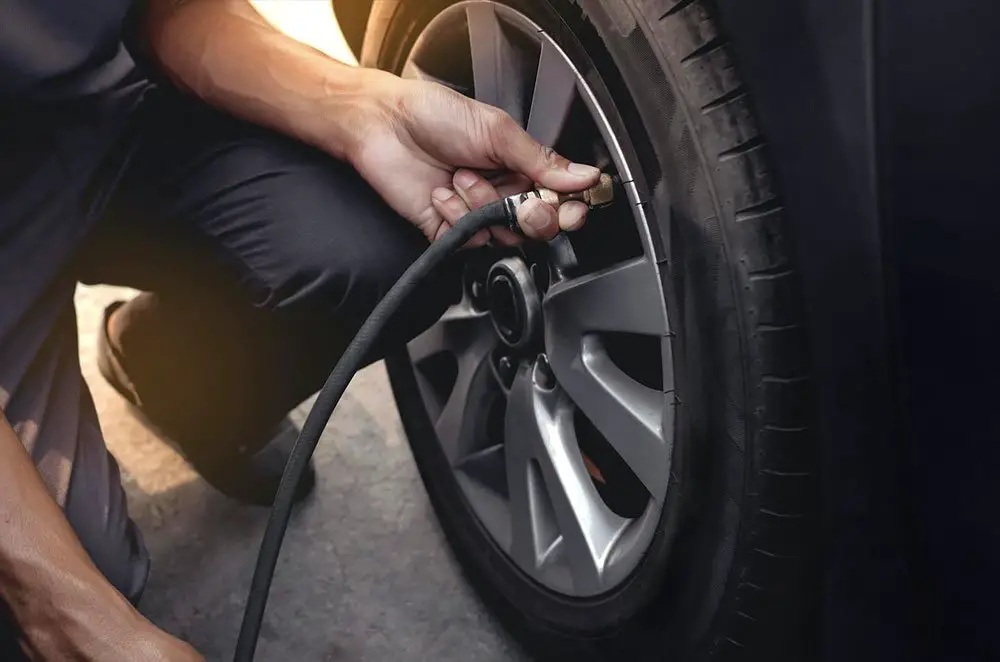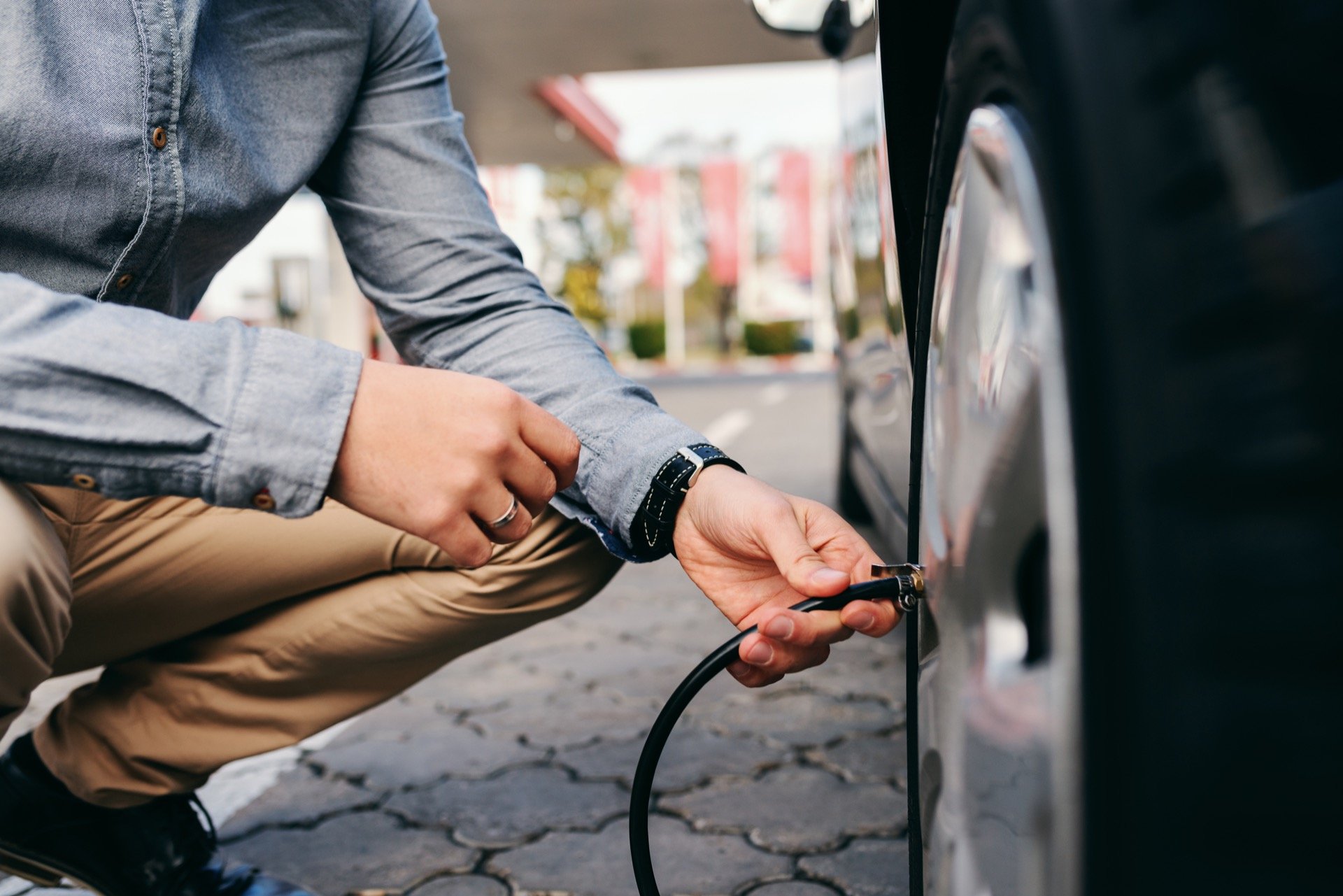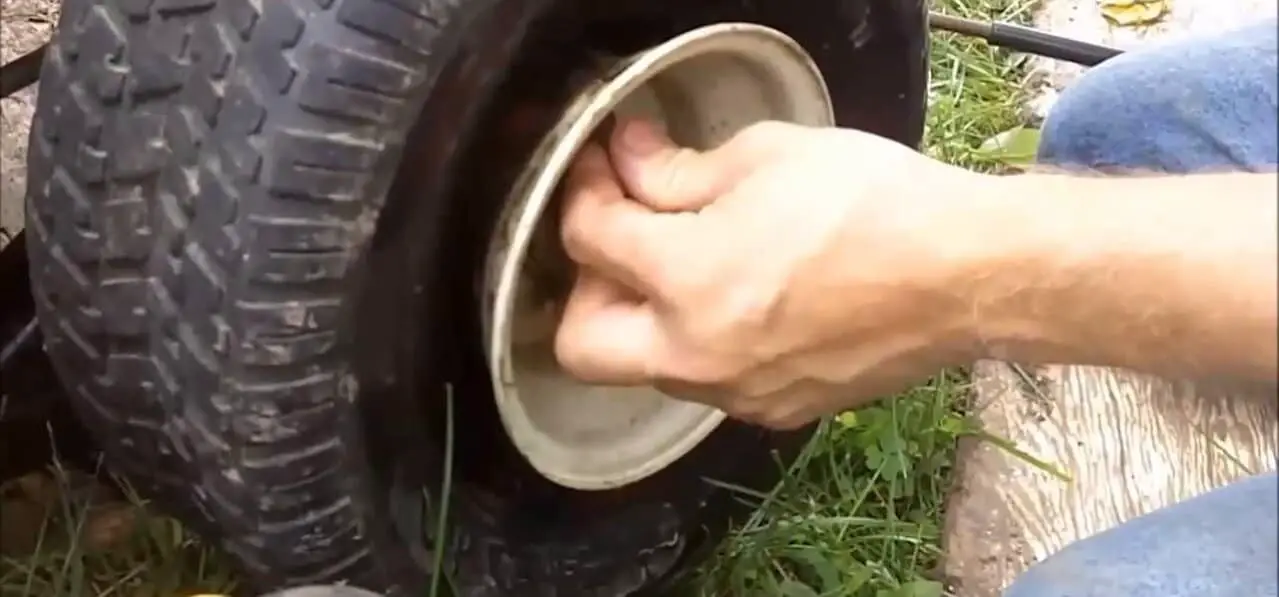Should You Put Air In Tires Before Or After Driving
You can drive at a lower tire pressure to be more accurate. Dont drive at a higher tire pressure when you plan to change it. Essentially, this is a process in which a tires temperature is set. Your recommended tire pressure ought to be 32 PSI, in other words you should put rubber onto the road and your tires get warmed up.
How To Inflate Car Tires At Home
Many of us have a misconception that inflating a car tire is a tough job and doing it is just not possible at home. Well, it is because you dont know the steps of how to inflate car tires at home.
If you know how to do it, you will never do it from outside again as these simple things can cost a lot of money. Moreover, you can inflate the car tires anytime you need if you know the techniques properly.
Hence, it can be a great help whenever there is an emergency, along with saving your money. However, life is unpredictable, and machines can develop a problem at any time without notice. Thats why the best is to be ready for everything. Most importantly, gaining knowledge about something never goes into vain.
Before moving directly into details, let us at first know what tools we need for inflating our car tires perfectly:
Replace The Valve Caps
Do you remember the valve caps we put in our pocket earlier? After inflating your car tires, replace the valve caps of all the wheels to prevent the pressure from escaping.
An essential tip to take away is if your tire is warmed up, you could inflate it to three PSI above the recommended pressure. This will compensate for the expansion caused by the heat.
Don’t Miss: How To Remove Hail Dents From Car
Risks Of Underinflated Or Overinflated Tires
Inflated tires certainly have immense advantages over flat tires. Having said that, inflating tires also has some added risk factors too. Because these days, most car users are looking for DIY ways to repair and maintain a job all by themselves. Hence, there is always a risk for underinflation and overinflation when it comes to inflating tires.
How Much Air Should Be In My Tires After Driving

Newer cars are usually equipped with a sticker inside the drivers door which informs drivers of their recommended tire pressure. Generally, the specifications are found in the owners manual if the door doesnt have a sticker. Cold tires are generally recommended to have 32 to 35 pressure psi in them.
Don’t Miss: Automotive Clear Coat Repair
Is Presta Better Than Schrader
Presta valves are easier to pump than Schrader, because they have no valve spring to overcome. In narrow rims, clincher tires also leave insufficient space between tire beads for larger Schrader valves. In contrast Schrader valves are more robust, universally used, and have an easily removable core.
Where To Buy Car Key Battery
Category: Cars 1. Batteries For Key Fobs Best Buy Best Buy customers often prefer the following products when searching for Batteries For Key Fobs. · Energizer 377 Batteries , Silver Oxide Button Cell Best Buy customers often prefer the following products when searching for Car Remote Batteries. ·
You May Like: How To Get Forward Bite On A Sprint Car
How Horsepower Required For Inflating Tires
Horsepower or HP is the unit of power provided by the motor and it does not directly impact the air compressor performance because the HP only works for air tanks to fill the air. Higher HP means it can fill the air tank faster.
And if I talk about the horsepower required for inflating air compressors then it requires 0.2 to 1 HP of air compressor is enough to get optimum performance. Because Inflation is a short term light-duty task and it does not require a high HP.
Why Should You Check Your Tire Pressure
The number one reason why you should periodically check your tire pressure is SAFETY, but there are monetary and handling reasons as well:
- Longer lasting tires
- Reduced risk of accidents and blow outs
- Better fuel economy
- Reduced carbon footprint
Proper tire pressure is needed to drive safely and efficiently. According to a 2009 report by the National Highway Traffic Safety Administration:
about 28% of light vehicles on our Nations roadways run with at least one underinflated tire. Only a few psi difference from vehicle manufacturers recommended tire inflation pressure can affect a vehicles handling and stopping distance. Poor tire maintenance can increase incidences of blowouts and tread separations. Similarly, underinflation negatively affects fuel economy.
When your tires are underinflated, the tires get fatter, increasing their surface area. This causes high heat generation and extra resistance that could result in higher fuel costs, blown out tires, tire wear, and loss of control.
If you feel like youre spending too much at the gas pump, it might be your tires. According to the US Department of Energy:
You can improve your gas mileage by 0.6% on averageup to 3% in some casesby keeping your tires inflated to the proper pressure. Under-inflated tires can lower gas mileage by about 0.2% for every 1 psi drop in the average pressure of all tires.
Recommended Reading: What Credit Bureau Does Car Dealers Use
Two: Check The Pressure
Compare the measured psi to the recommended psi of your tyres. To figure this out, first determine your tyresizeby checking the numbers on the sidewall of the tyre. Then compare this number against the recommendedpressures.Youll find these in your owners manual and often on the inside of the drivers door sill or inside thefuelcap.
Check out our extensive tyre pressure guide forfurther advice.
How To Find The Right Tyre Pressure
You should be able to find the recommended pressure for your tyres on a small sticker on your bodywork, or in the vehicle handbook.
Alternatively, you could use online tools such as tyrepressures.com.
Keep an eye out for different pressures between tyres, and be aware that you may need extra inflation on rear tyres if you frequently travel with heavy luggage or rear seat passengers.
Read Also: Fix Clear Coat On Car
What To Know About Checking And Filling Your Tire Pressure
In the past, it was necessary to keep a tire gauge handy, so that you could periodically check the pressure of your tires. Thanks to advances in technology, however, checking the pressure and keeping the tires filled to the proper pressure is now easier than ever before. Your vehicle can tell you when the tires need air, but that doesnt mean that you should always rely on that technology. To give you a better idea of how often you should be checking and filling your car tires, lets dive a bit deeper into tire air pressure.
The air pressure in your tires can change drastically depending on the temperature outside. They see the most fluctuation in winter, as the cold temperatures can cause the pressure to drop by as much as five pounds-per-square-inch . Considering that most tires recommend a PSI between 30 and 40, losing as much as five PSI can be pretty drastic, and if the pressure is not corrected, it can lead to some major issues.
As the seasons have such an effect on the pressure of your tires, how often youre checking the pressure ultimately depends on the season. For that reason, lets break things down into both winter and summer.
Should All 4 Tires Have The Same Psi

Tire pressure differences between front and rear is acceptable. Car manufacturers dont usually set them up that way in most cars, some do it depends on the car. Car manufacturers dont usually set them up that way in most cars, some do it depends on the car.
Don’t Miss: How Much To Register A Car In Ca
Common Question About Inflating Car Tires
How do you know how much air to put in your tires?
Look at your cars owners manual or door jam to find the correct tire pressure.
How often should I inflate my tires?
As needed via temperature or inflation imperfections. Learn all about tire pressure and when exactly to inflate them via our tire air pressure page.
AFFILIATE DISCLOSURE STATEMENT
We are a participant in the Amazon Services LLC Associates Program, an affiliate advertising program designed to provide a means for us to earn fees by linking to and affiliated sites.
SECURITY STATEMENT
The statements expressed above are only for informational purposes and should be independently verified based on your own discretion. Parts, tools, replacements, and fixes are to be done/used at your own risk. Be sure to do your own due diligence when working on a vehicle.
TOP RATED REVIEWS
“Thanks for the video and excellent explanation. Made changing my condenser on my 2018 suburban a breeze. Only issue Is, my wife thinks I’m possessed, everything I do now is followed up with a “Badda Bing!””
The Tyre Is Punctured Or Torn
This is the most probable cause, yet it could be surprisingly hard to diagnose. Punctures could be caused by an external object perforating the tyre, creating a small hole in the rubber through which the air could escape. Punctures can usually be remedied by applying a patch to the inner surface of the tyre to seal off this hole.
You could also try using a can of tyre sealant: injecting this goo into a leaking tyre will often seal it off sufficiently to stay inflated long enough to get you home. Avoid the temptation of plugging the hole with a proprietary tyre repair kit , unless you’re really stuck in the middle of nowhere with no alternative the action of inserting a plug into the tyre’s tread could easily damage the tyres carcass , leading to the formation of air bubbles in the tyre or even inducing a complete rapid deflation . This is a safety risk, and should only be considered as a last resort.
Torn tyres are something else entirely and usually occur as a result of a cut in the sidewall . This could be caused by a sharp rock or something similar slicing into the sidewall . Such damage can unfortunately not be treated by the roadside, as there simply doesn’t exist a patch or sealant strong enough to cover up a torn tyre.
Don’t Miss: What Stores Can I Use My Synchrony Card
Physical Damage To The Wheel Or Its Rim
We’ve already discussed damaged tyres, but tyres failing to inflate could sometimes also be a result of a damaged wheel. Alloy wheels are especially sensitive to this because they’re easily damaged by potholes, which could lead to cracks developing at the interface between wheel and tyre.
This poses an additional safety risk, as there’s a chance that the wheel might disintegrate at speed, which will lead to a total loss of control of the vehicle. Always inspect the wheel carefully when you’re faced with a mysterious pressure loss or inflation failure if it’s not the tyre itself or the valve which is leaking, chances are that you could be faced with replacing the wheel itself.
Hopefully, this list will help you with troubleshooting the next time you’re faced with a tyre that simply refuses to inflate. Use this information when you visit the tyre repair workshop it may just save you some money if you know exactly what’s wrong beforehand.
How To Check Tyre Tread
At the same time as checking the air pressure of your cars tyres, take a couple of minutes to perform a visual inspection and check the tread depth of the tyres.
Read Also: How To Transfer Car Title In Arizona
How To Inflate Car Tires
Its one of the keys to achieving a more comfortable and safer journey.
How to inflate car tires
Taking good care of your tires is indeed a must. Achieving this does make your ride safer be it during short distance or long distance trips. On top of that, your cars fuel economy figures are also affected by this, as underinflated tires have a higher rolling resistance which then reduces the fuel efficiency of your vehicle. Overinflated tires, on the other hand, could affect your cars ride and comfort, not to mention, itll wear quicker and requires a replacement sooner. Underinflated tires are also prone to damage because you can bend and mangle the sidewall, which constitutes a replacement right away.
Related:When is it time to replace your tires?
While modern cars nowadays come with different types of spare tires which should keep you covered during unexpected situations, its still best to maintain the proper tire pressure in order to avoid any of the following circumstances. With that, we shall give you some tips and tricks on how to properly inflate car tires.
Four: Replace Your Caps
Remember to put your valve caps back on and reset your cars tyre pressure warning light if it doesnt happenautomatically.
If your tyres are losing pressure quickly, you might need new tyres. If so, pop to your local HalfordsAutocentrewhere our colleagues will be more than happy to help select and fit them for you, or ask for a free safetycheckwhere well check your tyres, as well as other critical components on your vehicle.
Recommended Reading: How To Get Hail Dents Out Of Cars
How To Inflate Car Tires At Home Using Tire Inflator
Tires are the soul of every car. You may have a lavish car with high-quality components, but without inflated tires, the car just needs to stay in the garage.
The good news is inflating tires is a piece of cake no matter where your car is when you know how to inflate car tires at home. There was a time when people had to rely on gas stations or car repairing shops to put air in their car tires. Not only that people had to pay for inflating car tires but also faced so much hassle when the car tires get punctured where no tire inflators are available.
For this reason, the manufacturers have introduced versatile car tire inflators considering the convenience of the users. And, when you have a tire inflator in your car, you wont have to worry about flat tires anymore in the middle of any journey. Also, properly inflated tires mean you can run for more mileage with outstanding performance.
If you are planning to purchase or use a tire inflator at home, here is your chance to learn how to put air in car tires at home. In this article, I am going to share the advantages of inflated tires, the risk of overinflated tires, how to use tire inflators, and the features of choosing a high-quality inflator.
Lets get started!
Inflating A Car Tire With Parts Cleaner

Step 1. Lift the car using a jack or a crowbar slightly from the ground.
Step 2 -Remove the tire without enough air or the flattened tire from the car.
Step 3 -Place the said tire on the floor some few meters from your house, garage, or your car.
Step 4.-Pick your parts cleaner and apply it around the rim of the detached tire.
Step 5-After, ensuring you have well applied the cleaner, ignite using a candle lighter.
Step 6- Carefully check the tire as it inflates gradually, and once it gets inflated, extinguish the fire immediately using any better means.
Method 3
Inflate the tire using WD40 Multipurpose fluid
WD 40 multipurpose is among the most popularly used flammable agents. It is not a wonder to find it on the shelf of most peoples houses. It can give your tire a little boost to enable you to drive safely to your destination.
Step 1 -Either use a jack, crowbar, or any other tool to lift your car some inches from the ground.
Step 2 Detach the tire that requires pumping from the car, mainly when you are outdoor.
Step 3 -Place the detached tire on the ground in a safe distance with other items.
Step 4 -Pick your WD40 multipurpose fluid and apply it around the rim of a flat tire.
Step 5 -Ignite the WD40 cautiously using candle lighter.
Step 6- Wait for the tire to inflate. In case the tire inflates, and the fire takes longer to put off, you can extinguish using available fire extinguishers.
But what is the science behind these methods?
Precautions
Also Check: Tips For Car Wash Attendants